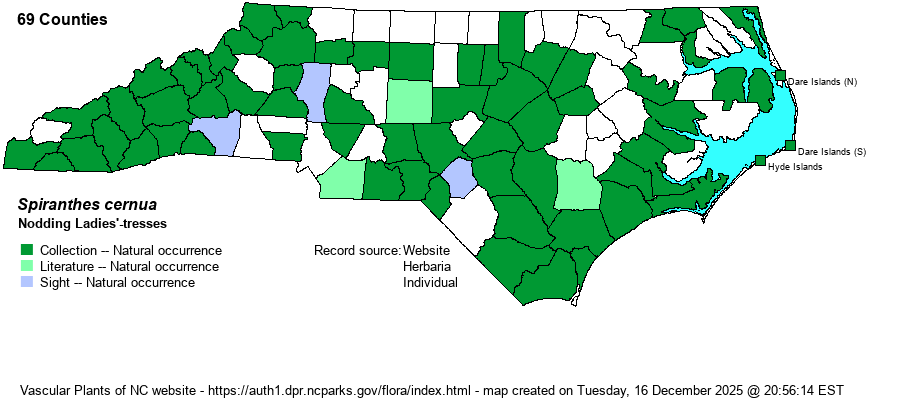| Author | (L.) L.C. Richard | |
| Distribution | Essentially statewide, though relatively scarce in much of the Piedmont and northern Coastal Plain. Note that Pace and Cameron (2017) have split out several new species from Spiranthes cernua (broad sense), though this apparently does not affect the range in NC -- just abundance levels.
The strict sense S. cernua, based on the Pace and Cameron (2017) map, ranges from NS south to the FL Panhandle and eastern TX. They have broken off the northern part of the range as S. incurva. Spiranthes cernua (broad sense) includes these two and has the species range north into southern Canada, northwest to MN, and then south to the Gulf Coast. | |
| Abundance | Uncommon to fairly common (probably) in the Mountains, as some or many of the former records probably now relate to the recently-split S. arcisepala; fairly common in the Sandhills and southeastern Coastal Plain. Generally rare to uncommon in the Piedmont and the rest of the Coastal Plain. | |
| Habitat | This is a species of damp to wet spots, mostly in sunny situations. It occurs in ditches, bogs, open swamps, beaver pond and impoundment margins, seepages, and other such sites. It usually grows in fairly dense colonies, at times of several dozen plants. | |
| Phenology | Blooms in late summer into fall, generally from July into November (September-November in the Sandhills). Fruits shortly after flowering. | |
| Identification | This is a relatively short Spiranthes, mainly 6-12 inches tall. It has a more dense flower spike than all other state species of Spiranthes, with flowers typically in several vertical ranks, some plants with straight ranks but other plants with these spiraled. Each of the many dozens of white flowers is about 1/3-inch long and rectangular in shape when viewed from the side; the lip is generally white on both sides. Other species in the genus have more slender flower clusters with fewer flowers, or flowers in a single rank/spiral. This flower cluster is often 5-6 inches tall, covering about the top half of the stem. There are a few narrow leaves near the base, but these are of little help in identification. This is, by far, the most frequently encountered Spiranthes outside the Coastal Plain, and even in the southeastern Coastal Plain is it not hard to find. | |
| Taxonomic Comments | Although this has always been a good species, in recent decades a number of other species have been pulled out of S. cernua, not just once but on several occasions, including in 2017.
| |
| Other Common Name(s) | Generally none. However, the flowers are not really nodding, but tend to extend straight out from the stem! | |
| State Rank | S4 | |
| Global Rank | G5 | |
| State Status | | |
| US Status | | |
| USACE-agcp | FACW link |
| USACE-emp | FACW link |

